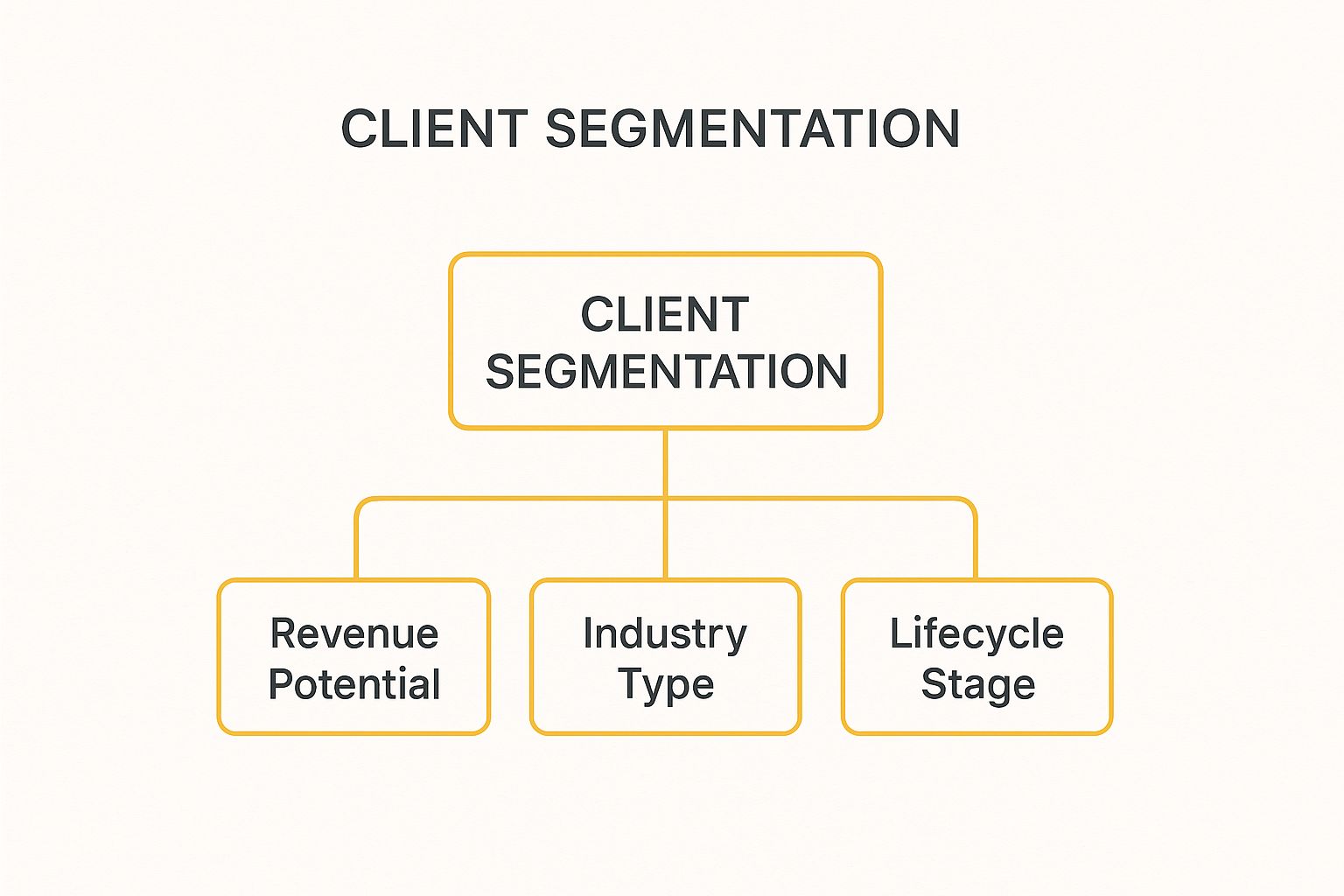In today's competitive market, simply delivering a service is not enough. Lasting success is built on the foundation of strong, resilient client relationships. For busy professionals like mortgage brokers, real estate agents, and small business owners, managing these connections effectively can feel like a secondary job. Yet, the cost of neglect is high: lost revenue, diminished loyalty, and a weakened reputation.
The key is not working harder, but working smarter by adopting proven client relationship management strategies that create value and build genuine trust. The challenge often lies in integrating these strategies into a packed schedule. This is where tools designed for efficiency, like OnSilent's smart call management, become invaluable. By handling communications intelligently, you free up critical time to focus on what truly matters: nurturing your client connections.
This article moves beyond generic advice to explore nine powerful strategies, complete with actionable steps and real-world scenarios. We will provide fresh perspectives and practical implementation details to help you transform your client interactions from transactional to transformational. You will learn how to build a loyal client base that fuels sustainable growth, turning every relationship into a cornerstone of your business.
1. Master a Truly Customer-Centric Approach
Adopting a genuinely customer-centric approach is one of the most foundational client relationship management strategies available. This goes beyond a simple slogan; it involves placing your client at the absolute centre of every business decision, process, and interaction. It marks a fundamental shift from focusing on what you sell to understanding how you help your clients succeed.

This strategy requires deeply understanding your clients' needs, goals, and pain points to deliver personalised experiences that build long-term value and loyalty. When a real estate agent knows a family's top priority is a safe neighbourhood with good schools, every property recommendation reflects that understanding, creating a powerful, trust-based connection.
How to Implement This Strategy
A customer-centric culture is built, not declared. Start by mapping the entire client journey, from the first enquiry to post-sale follow-ups.
- Identify Touchpoints: Pinpoint every interaction a client has with your business.
- Analyse Pain Points: At each stage, ask what challenges or frustrations clients might face.
- Align Your Team: Ensure every department, from sales to administration, is unified around the goal of client success.
- Gather Feedback: Implement regular feedback loops like surveys or brief follow-up calls to continuously refine your approach.
Key Insight: True customer-centricity means proactively solving problems before the client has to ask. It turns transactions into partnerships.
OnSilent in Action
A busy mortgage broker uses OnSilent to ensure no client concern is ever missed. After sending out an application update, they know any return calls from clients with urgent questions won't get lost in a cluttered voicemail inbox. OnSilent’s organised transcription and prioritisation allow the broker to identify and respond to critical messages instantly, demonstrating a firm commitment to client care and strengthening the relationship during a stressful process.
2. Implement a Proactive Communication Strategy
A proactive communication strategy is one of the most powerful client relationship management strategies for building trust and preventing issues. Instead of waiting for a client to call with a problem, this approach involves systematically reaching out with valuable information and updates. It’s about anticipating needs and keeping clients informed, which transforms the dynamic from reactive problem-solving to a collaborative partnership.

This strategy demonstrates that you are actively managing their account and invested in their success. For a property manager, this could mean sending a quarterly report on maintenance trends in the building before a landlord asks, or for a real estate agent, providing weekly market insights to a client who is considering selling. These actions build confidence and show you’re always a step ahead.
How to Implement This Strategy
Effective proactive communication relies on a well-organised system, not just random check-ins. It ensures every message adds value rather than just creating noise.
- Establish Communication Preferences: Ask clients how and when they prefer to receive updates (e.g., email, SMS, a quick call).
- Create a Communication Calendar: Schedule routine updates, such as weekly progress reports or monthly performance summaries, to ensure consistency.
- Add Value with Every Touchpoint: Share relevant industry news, helpful tips, or performance insights instead of just "checking in."
- Use Automation Wisely: Automate routine notifications but personalise crucial messages to maintain a human touch. Explore how to build a framework for effective client communication to refine your approach.
Key Insight: Proactive communication turns silence into an opportunity. It fills the void with reassurance and value, ensuring clients feel prioritised and confident in your services.
OnSilent in Action
A busy trades professional uses OnSilent to manage their proactive communication with clients on large projects. After completing a stage of work, they leave themselves a voice note via OnSilent to send a progress update with photos to the client the next morning. This system ensures they never forget to provide these crucial updates, even on their busiest days. OnSilent's transcription service makes it easy to review the key points, ensuring the email is clear and professional, which helps maintain client satisfaction and minimises anxious follow-up calls.
3. Value-Based Relationship Building
This client relationship management strategy moves beyond transactional service delivery to focus on creating and demonstrating tangible value. It’s about deeply understanding what success looks like for your client and proactively aligning your expertise and resources to help them achieve it. This approach transforms you from a service provider into an indispensable partner in their success.

When a property manager not only collects rent but also provides a landlord with quarterly reports on local market trends and preventative maintenance schedules that increase property value, they are delivering measurable value. This shifts the relationship from a simple service agreement to a strategic partnership focused on mutual growth, which is key to effectively managing client expectations.
How to Implement This Strategy
Delivering consistent value requires a structured and intentional approach. It starts with defining what your client truly values and then building processes to deliver it.
- Define Success Metrics Together: At the start of a relationship, collaboratively establish clear, measurable goals. What does a successful outcome look like for them?
- Create Value Reports: Regularly share reports or updates that explicitly demonstrate the value you've provided, whether it's cost savings, time saved, or progress toward a key objective.
- Invest in Expertise: Become a source of industry insights and thought leadership. Share relevant articles, data, or advice that helps your clients make better decisions.
- Document and Share Results: Develop case studies from past successes to show potential and existing clients the concrete results you can deliver.
Key Insight: Value is defined by the client. Building a relationship on this foundation ensures your efforts are always relevant and impactful, fostering deep-seated loyalty.
OnSilent in Action
A trades professional uses OnSilent to capture every detail during initial project consultations. While on-site, they can verbally note the client’s key concerns, like sticking to a strict budget or completing work before a family event. OnSilent transcribes these notes, creating a clear record of the client's definition of "value". This allows the professional to tailor their proposal and project execution precisely to these priorities, demonstrating from day one that they are focused on delivering what truly matters to the client.
4. Segmented Client Management
Not all clients are the same, so your management approach shouldn't be either. Segmented client management is one of the most effective client relationship management strategies for tailoring your efforts. It involves strategically categorising clients based on specific criteria, allowing for more personalised communication, service delivery, and resource allocation.

This strategy moves beyond a one-size-fits-all model, enabling businesses to focus their energy where it will have the greatest impact. For example, a property manager might segment clients into residential landlords and commercial property owners, each requiring different communication styles and service priorities. This targeted approach demonstrates a deeper understanding of their unique needs.
How to Implement This Strategy
Effective segmentation begins with data analysis and clear definitions. You need to decide which criteria matter most for your business and build distinct communication plans for each group.
- Define Your Segments: Use criteria like revenue potential, lifecycle stage (new vs. long-term), or service needs to create meaningful client groups.
- Tailor Your Approach: Develop specific strategies for how you will communicate with and serve each segment. A high-value commercial client might receive proactive quarterly reviews, while a new residential client gets a detailed onboarding sequence.
- Train Your Team: Ensure every team member understands the different segments and knows how to adjust their interactions accordingly.
- Review and Refine: Client needs and business priorities change. Re-evaluate your segments periodically to ensure they remain relevant and effective.
Key Insight: Segmentation isn't about valuing some clients more than others; it’s about understanding that different clients value different things from your service.
OnSilent in Action
A growing trade business uses segmentation to manage its diverse client base of one-off residential jobs and ongoing commercial contracts. By using OnSilent, the business owner can easily tag and filter voicemails based on the client type. Urgent calls from a major commercial account are instantly flagged for immediate callback, while messages about smaller residential queries are grouped for the administrative team to handle efficiently. This organised system ensures all clients receive timely responses appropriate to their needs, strengthening every relationship.
5. Embrace Digital CRM Integration
Embracing digital Customer Relationship Management (CRM) integration is a pivotal strategy for modernising client interactions. This involves strategically using CRM technology like Salesforce or HubSpot to centralise client data, automate routine tasks, and gain actionable insights. It transforms your client management from a manual, memory-based process into a streamlined, data-driven operation.
This approach ensures that every piece of information, from initial contact details to follow-up schedules, is organised and accessible. For a property manager, a well-integrated CRM automatically logs tenant maintenance requests and schedules follow-ups, ensuring nothing slips through the cracks and improving tenant satisfaction. These powerful client relationship management strategies are essential for scaling a business effectively.
How to Implement This Strategy
Successfully integrating a CRM requires more than just purchasing software; it demands a strategic rollout focused on adoption and utility.
- Choose Wisely: Select a CRM that integrates smoothly with the tools you already use, such as your email client or accounting software.
- Prioritise Data Quality: Implement processes for regularly cleaning and updating client data to ensure your insights are accurate and reliable.
- Train Your Team: Provide thorough training to ensure your entire team understands the CRM's capabilities and uses them consistently.
- Automate Strategically: Use automation for repetitive tasks like sending welcome emails or appointment reminders, freeing up your team for high-value, personal interactions.
Key Insight: A CRM is not just a digital address book; it’s a central nervous system for your client relationships, enabling proactive and personalised service at scale.
OnSilent in Action
A busy real estate agency uses its CRM to track potential buyers. By integrating OnSilent, every missed call from a prospective buyer is automatically transcribed and linked to the correct client record in their CRM. This allows agents to see the full context of a client's enquiry before returning the call, enabling a more informed and personalised conversation that accelerates the sales process and strengthens the relationship from the very first interaction.
6. Employ Account-Based Relationship Management
Account-Based Relationship Management is a powerful, focused strategy that treats high-value individual client accounts as unique markets. Instead of casting a wide net, this approach concentrates resources on nurturing and expanding relationships with a select few key clients who hold significant strategic importance or revenue potential.
This method involves developing deeply personalised client relationship management strategies for each target account. For a property manager, this might mean creating a bespoke service plan for a major commercial client with a large portfolio, offering dedicated reporting and proactive maintenance schedules that align perfectly with their business objectives, fostering immense loyalty.
How to Implement This Strategy
Successfully implementing an account-based approach requires a strategic shift from volume to value. It starts with identifying which accounts merit this level of specialised attention.
- Select Strategic Accounts: Identify clients based not just on current revenue, but on growth potential, industry influence, and long-term partnership value.
- Map Key Relationships: Develop a clear understanding of the organisational structure within the client's business. Identify key decision-makers, influencers, and daily contacts.
- Create Bespoke Value: Craft account-specific value propositions that directly address their unique challenges and goals.
- Establish Regular Reviews: Schedule consistent strategic meetings to review progress, adapt to changes, and ensure your service remains aligned with their evolving needs.
Key Insight: This strategy transforms your role from a mere service provider into an indispensable strategic partner, deeply integrated into your client's success.
OnSilent in Action
A busy real estate agent specialising in high-net-worth investors uses an account-based strategy to manage their top three clients. They can’t afford to miss a single call from these key accounts. By assigning unique numbers to each client, OnSilent’s virtual receptionist service can immediately identify and prioritise their calls, ensuring they receive an instant, personalised response. This system guarantees that the agent’s most valuable relationships are always given the white-glove treatment they expect, reinforcing trust and securing future business.
7. Prioritise Emotional Intelligence in Client Relations
Effective client relationship management strategies are not just about processes; they are about people. Prioritising emotional intelligence (EQ) involves understanding, managing, and leveraging emotions in every client interaction. It’s the ability to recognise a client's unspoken feelings and respond with empathy, turning a standard service call into a moment of genuine connection and trust.
This strategy empowers professionals to navigate complex and often stressful client situations with grace. A real estate agent using high EQ can sense a first-home buyer's anxiety and offer reassurance and clear guidance, rather than just focusing on the sale. This emotional attunement builds a much stronger, more resilient professional relationship.
How to Implement This Strategy
Integrating emotional intelligence requires a conscious effort to develop self-awareness and empathy within your team.
- Invest in Training: Provide resources or workshops for client-facing staff on the core components of emotional intelligence.
- Practise Active Listening: Train your team to listen not just for facts, but for the underlying emotions. What is the client really saying?
- Acknowledge Feelings First: Before jumping to a solution, validate the client's feelings. A simple "I understand this is frustrating" can de-escalate tension immediately.
- Cultivate Empathy: Encourage your team to put themselves in the client's shoes to better understand their perspective and motivations.
Key Insight: Logic makes clients think, but emotion makes them act. Building an emotional connection is the fastest way to earn unwavering loyalty.
OnSilent in Action
A property manager receives an urgent, panicked call from a tenant about a major leak. Instead of just hearing the problem, OnSilent’s clear transcription captures the tone and emotional distress in the tenant's words. The manager can instantly grasp the severity and the tenant's anxiety, allowing them to start their return call with, "I've received your message and can hear how stressful this is. Help is on the way." This immediate emotional validation, enabled by OnSilent, reinforces trust and shows the tenant they are truly being heard.
8. Client Success and Outcome Management
Moving beyond traditional account management, this proactive strategy centres on ensuring your clients achieve their desired outcomes. It's a key pillar of modern client relationship management strategies, shifting the focus from simply servicing an account to actively guiding the client toward success. This approach transforms your role from a vendor into an indispensable partner invested in their results.
This methodology involves deeply understanding what success looks like for your client and then systematically working to help them achieve it. For a property manager, this isn't just about collecting rent; it's about ensuring the landlord achieves their target rental yield and minimises vacancy periods, demonstrating tangible value that secures long-term business and referrals.
How to Implement This Strategy
Implementing outcome management requires a structured, collaborative process. It starts with defining what success means before you even begin delivering your core service.
- Define Success Metrics: Work with your client from day one to establish clear, measurable goals. What specific outcome are they trying to achieve?
- Create a Success Plan: Outline the key milestones and check-in points on the journey to achieving their goals.
- Track Client Health: Use tools and regular communication to monitor progress and identify potential roadblocks before they become major issues.
- Invest in Training: Ensure your team understands they are not just administrators but success partners, equipped to guide and advise clients effectively.
Key Insight: Client success management is about prevention, not just reaction. It's about ensuring your client gets the full value of your service, which in turn maximises their loyalty to you.
OnSilent in Action
A trades professional uses OnSilent to manage their client success process for a large renovation project. After each project milestone, they send a quick update. Any missed calls from the client asking about progress or next steps are instantly transcribed by OnSilent. This allows the tradesperson to immediately identify and address concerns, keeping the project on track and ensuring the client feels supported and confident in the outcome, cementing a strong, trust-based relationship.
9. Implement Multi-Touchpoint Engagement
Implementing a multi-touchpoint engagement strategy means creating meaningful interactions with clients across various channels throughout their entire journey with your business. It’s about being present and adding value wherever your clients are, from social media to email to phone calls. This approach ensures your brand message is consistent and your relationship feels connected, not fragmented.
This is a cornerstone of modern client relationship management strategies because it acknowledges that clients don't interact with businesses in a single, linear way. A prospective home buyer might first see a real estate agent’s ad on Facebook, then visit their website, call to ask a question, and finally meet in person. Each touchpoint is an opportunity to strengthen the relationship and build trust.
How to Implement This Strategy
A successful multi-touchpoint strategy requires careful planning and coordination to deliver a seamless client experience.
- Map the Client Journey: Identify every possible interaction point a client could have with your business, from initial awareness to post-sale support.
- Ensure Consistent Messaging: Your brand voice, value proposition, and offers should be uniform across all channels to avoid confusing your clients.
- Coordinate Team Efforts: Ensure your sales, marketing, and service teams are aligned, so a client doesn't receive conflicting or repetitive communications.
- Track Engagement Holistically: Use tools to monitor how clients interact across different platforms to gain a complete picture of their engagement.
Key Insight: A strong multi-touchpoint strategy makes your business feel omnipresent and supportive, reinforcing client confidence at every step.
OnSilent in Action
A property management firm uses a multi-touchpoint strategy to keep landlords and tenants informed. They send email updates, post maintenance alerts on their client portal, and handle urgent repair requests via phone. When a tenant leaves an urgent voicemail about a water leak, OnSilent immediately transcribes and flags it. This allows the property manager to respond swiftly, demonstrating reliability and preventing a small issue from escalating, thereby strengthening trust across multiple communication channels.
Client Relationship Management Strategies Comparison
| Strategy | Implementation Complexity 🔄 | Resource Requirements ⚡ | Expected Outcomes 📊 | Ideal Use Cases 💡 | Key Advantages ⭐ |
|---|---|---|---|---|---|
| Customer-Centric Approach | High – requires cultural change and alignment | High – initial resource-intensive | High client satisfaction, loyalty, and lifetime value | Businesses wanting deep client insights and personalization | Strong differentiation, reduced churn |
| Proactive Communication Strategy | Medium – process-driven with automation | Medium – need for dedicated communication | Increased engagement, trust, and retention | Client-facing roles needing issue anticipation and updates | Builds trust, prevents escalation |
| Value-Based Relationship Building | High – time and expertise intensive | High – requires industry knowledge and advisory | Deep strategic partnerships, referrals, premium pricing justification | Industries valuing measurable client ROI and strategic impact | Positions as strategic partner, drives referrals |
| Segmented Client Management | Medium to high – requires data and multiple approaches | Medium – data management and team training | Efficient resource use, scalable tailored management | Organizations with diverse client base needing segmentation | Resource optimization, growth opportunity ID |
| Digital CRM Integration | Medium – technology setup and adoption | Medium to high – software costs and training | Improved data accuracy, collaboration, scalability | Companies looking to streamline and automate client management | Better tracking, team efficiency |
| Account-Based Relationship Management | High – intensive customization and expertise needed | High – focused resources on key accounts | Deeper client relationships, higher revenue per client | Managing key strategic accounts with customized plans | High retention, improved competitive position |
| Emotional Intelligence in Client Relations | Medium – training focused, hard to scale | Medium – training investment | Stronger personal connections and client trust | Client-facing teams prioritizing empathy and trust-building | Improved conflict resolution and loyalty |
| Client Success and Outcome Management | High – dedicated roles and long-term tracking | High – resources for success teams and tools | Higher retention, expansion, and advocacy | SaaS and subscription models focused on client outcomes | Clear value demonstration and advocacy |
| Multi-Touch Point Engagement | High – complex coordination across channels | High – requires cross-team coordination and content | Increased engagement, brand recall, and satisfaction | Brands needing consistent omnichannel client experiences | Multiple value-add opportunities, reduces gaps |
Turning Strategy into Your Competitive Advantage
The journey through these nine essential client relationship management strategies reveals a powerful truth: building exceptional client relationships is no longer a soft skill, but a hard-edged competitive advantage. From adopting a truly customer-centric mindset to integrating sophisticated digital CRM tools, each approach offers a distinct lever to pull. We have explored how segmenting your client base allows for tailored communication, how proactive outreach prevents issues before they arise, and how focusing on client success directly ties your efforts to their tangible outcomes.
These aren't isolated tactics to be deployed sporadically. Instead, think of them as interconnected components of a holistic system. A multi-touch point engagement strategy, for example, is far more effective when guided by the principles of emotional intelligence. Similarly, an Account-Based Relationship Management approach relies heavily on the foundation of value-based relationship building to succeed. The common thread weaving through all these methods is a commitment to intentional, personalised, and value-driven interactions.
From Insights to Action
Mastering these strategies transforms your business from a transactional service provider into an indispensable partner. This evolution is the key to creating sustainable growth, fostering unwavering loyalty, and generating a consistent stream of high-quality referrals. Strong client relationships act as a moat around your business, protecting it from market fluctuations and competitive pressures. When clients feel genuinely seen, heard, and valued, price becomes a secondary consideration.
The most significant barrier for busy professionals, from real estate agents to tradespeople, is often not a lack of intent but a lack of time and mental clarity. This is where strategic implementation becomes paramount.
- Prioritise Your Approach: Don't attempt to implement all nine strategies at once. Select one or two that address your most pressing business challenge right now. Is client churn a problem? Focus on Client Success and Outcome Management. Are you struggling to personalise your service? Start with Segmented Client Management.
- Create a Road Map: For your chosen strategy, outline clear, actionable steps. What specific actions will you take this week? This month? This quarter? Who on your team is responsible for what?
- Leverage Technology Wisely: The right tools are not about adding complexity; they are about creating capacity. Use technology to automate repetitive tasks, organise client data, and streamline communication, freeing you up to focus on the high-value, human elements of relationship building.
Ultimately, effective client relationship management strategies are about moving beyond simply managing a list of contacts. The goal is to cultivate a thriving community of advocates who not only continue to do business with you but actively champion your brand. Start small, be consistent, and watch as these focused efforts compound, turning your client relationships into your most powerful and enduring business asset.
Ready to clear the noise and create the focus needed to implement these powerful strategies? OnSilent filters your communications, ensuring you only see the messages that matter, so you can dedicate your energy to building stronger client relationships. Discover how to transform your client management by visiting OnSilent today.

